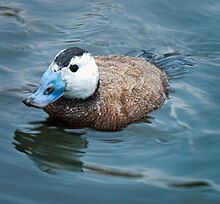White-headed duck
| White-headed duck | |
|---|---|

| |
| Male in summer | |

| |
| Female | |
| Scientific classification | |
| Domain: | Eukaryota |
| Kingdom: | Animalia |
| Phylum: | Chordata |
| Class: | Aves |
| Order: | Anseriformes |
| Family: | Anatidae |
| Genus: | Oxyura |
| Species: | O. leucocephala
|
| Binomial name | |
| Oxyura leucocephala (Scopoli, 1769)
| |

| |
| Oxyura leucocephala range
Breeding Resident Non-breeding Passage Vagrant (seasonality uncertain) Probably extinct
| |
The white-headed duck (Oxyura leucocephala) is a small
Taxonomy and systematics
The white-headed duck was originally described as Anas leucocephala by
It interbreeds with other species in its genus, such as the ruddy duck. The hybrids are fully fertile and capable of having viable offspring with both parent species.[4]
The species is monotypic. Different populations of the white-headed duck do not display significant genetic differences. However, some studies have found that they do display morphological differences, with western populations being larger in size, having darker ventral coloration, and males having more yellow feathers on their back. Dark phase birds have only been found in the western populations.[4]
In the genus Oxyura, it is generally thought to be related most closely to Maccoa duck. Some studies have also found that these two species form a clade with the blue-billed duck, although this is disputed and species relations between Oxyura ducks are unresolved.[4]
Description
Adult males have a grey and reddish body, a blue bill and a largely white head with a black cap and neck. Adult females have a grey-brown body with a white face and a darker bill, cap, and cheek stripe. Length is 43–48 cm (17–19 in) and weight is 580–750 g (1.28–1.65 lb).

Distribution and habitat

This duck breeds in Spain and
Behaviour and ecology
Diet
These birds dive and swim under water. They are
Conservation
This duck is considered
The white-headed duck is one of the species to which the Agreement on the Conservation of African-Eurasian Migratory Waterbirds (
References
- ^ . Retrieved 12 November 2021.
- ^ "Appendices | CITES". cites.org. Retrieved 2022-01-14.
- ^ Jobling, James. The Helm Dictionary of Scientific Bird Names. ChristopherHelm. p. 223.
- ^ .
- ^ White-headed Duck (Oxyura leucocephala) in Armenia. 2017. In online publication: "The State of Breeding Birds of Armenia". TSE NGO, Armenian Bird Census Council. Retrieved on 10 October 2017.
Further reading
- Gantlett, Steve (1993) The status and separation of White-headed Duck and Ruddy Duck Birding World6(7): 273-281

